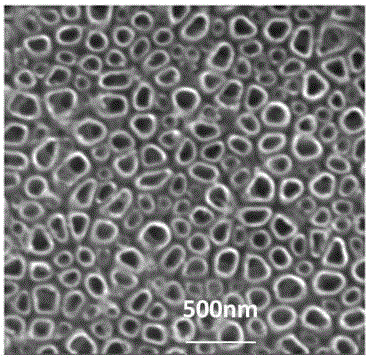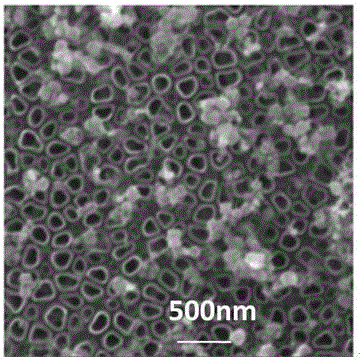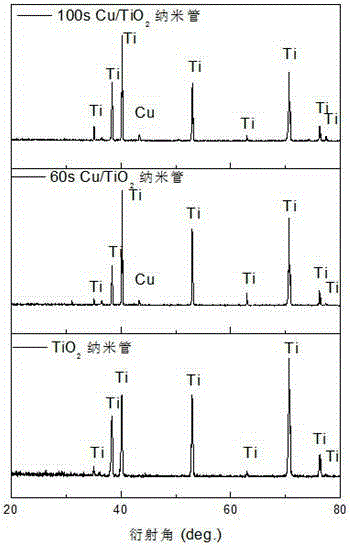Application of Cu-doped three-dimensional ordered amorphous titanium dioxide nanotube composite material
A three-dimensional ordered and composite material technology, applied in the development and research of new energy materials, can solve the problems of lithium-ion battery application research, such as few reports, to facilitate the reversible de/intercalation process, improve charge/discharge performance and cycle Stable performance, reduced internal resistance and the effect of charge transfer resistance
- Summary
- Abstract
- Description
- Claims
- Application Information
AI Technical Summary
Problems solved by technology
Method used
Image
Examples
Embodiment 1
[0022] Cu-doped three-dimensional ordered amorphous TiO 2 The nanotube array composite material is used as the working electrode of the lithium-ion battery: no additional conductive agent and binder are added, the Cu-doped three-dimensional ordered amorphous TiO2 nanotube array composite negative electrode material is directly used as the working electrode, and the lithium foil As the counter electrode and reference electrode, the Celgard2500 membrane is used as the diaphragm to contain 1mol / LLiPF 6 The mixture of ethylene carbonate (EC), diethyl carbonate (DEC) and dimethyl carbonate (DMC) is the electrolyte solution, in which the volume ratio of EC, DEC and DMC is 1:1:1, filled with high-purity A button-type simulated lithium-ion battery was assembled in an argon glove box, and its charge / discharge performance and cycle stability were tested by a constant current (50mA / g) charge / discharge method.
[0023] Cu-doped three-dimensional ordered amorphous TiO used in this example...
Embodiment 2
[0025] Cu-doped three-dimensional ordered amorphous TiO 2 Nanotube array composites used as working electrodes for lithium-ion batteries: three-dimensional ordered amorphous TiO doped directly with Cu without adding additional conductive agents and binders 2 The nanotube array composite negative electrode material is used as the working electrode, the lithium foil is used as the counter electrode and the reference electrode, and the Celgard2400 film is used as the diaphragm, with 1mol / LLiPF 6 The mixture of ethylene carbonate (EC) and diethyl carbonate (DEC) is the electrolyte solution, wherein the volume ratio of EC and DEC is 1:1, and the button-type simulated lithium is assembled in a glove box filled with high-purity argon Ion battery, and test its charge / discharge performance and cycle stability by constant current (50mA / g) charge / discharge method, see Figure 4 and Figure 6 , The specific capacity of the first discharge is 291mAh / g, and the stability of 50 charge / disc...
Embodiment 3
[0028] Cu-doped three-dimensional ordered amorphous TiO 2 Nanotube array composites used as working electrodes for lithium-ion batteries: three-dimensional ordered amorphous TiO doped directly with Cu without adding additional conductive agents and binders 2 The nanotube array composite negative electrode material is used as the working electrode, the lithium foil is used as the counter electrode and the reference electrode, and the Celgard2325 film is used as the diaphragm, with 1mol / LLiPF 6The mixture of ethylene carbonate (EC), diethyl carbonate (DEC) and dimethyl carbonate (DMC) is the electrolyte solution, in which the volume ratio of EC, DEC and DMC is 1:1:1, filled with high-purity A button-type simulated lithium-ion battery was assembled in an argon glove box, and its charge / discharge performance and cycle stability were tested by a constant current (50mA / g) charge / discharge method.
[0029] Cu-doped three-dimensional ordered amorphous TiO used in this example 2 Nano...
PUM
 Login to View More
Login to View More Abstract
Description
Claims
Application Information
 Login to View More
Login to View More - R&D
- Intellectual Property
- Life Sciences
- Materials
- Tech Scout
- Unparalleled Data Quality
- Higher Quality Content
- 60% Fewer Hallucinations
Browse by: Latest US Patents, China's latest patents, Technical Efficacy Thesaurus, Application Domain, Technology Topic, Popular Technical Reports.
© 2025 PatSnap. All rights reserved.Legal|Privacy policy|Modern Slavery Act Transparency Statement|Sitemap|About US| Contact US: help@patsnap.com



